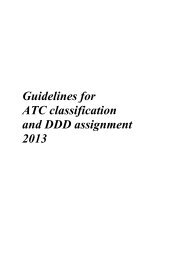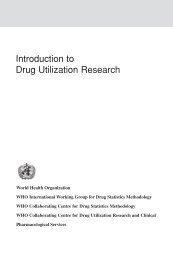Download - WHOCC
Download - WHOCC
Download - WHOCC
Create successful ePaper yourself
Turn your PDF publications into a flip-book with our unique Google optimized e-Paper software.
1 Introduction to the ATCvet classification system<br />
1.1 History of the ATC/DDD- and the ATCvet systems<br />
The basis for the ATCvet classification system is the ATC (Anatomical Therapeutic Chemical)<br />
classification system for human medicines, which was developed in Norway in the early<br />
seventies. The use of the ATC classification and the DDD (Defined Daily Dose defined as the<br />
assumed average daily dose of a substance used in its main indication in adults) as a unit of<br />
measurement was introduced in the Nordic countries in 1976.<br />
In 1982, the WHO Regional Office for Europe established the WHO Collaborating Centre for<br />
Drug Statistics Methodology in Oslo. The main tasks of the Centre are to develop and maintain<br />
the ATC/DDD system, and to stimulate and influence the practical use of the ATC system by cooperating<br />
with researchers in the drug utilization field.<br />
In 1996 WHO Headquarters in Geneva decided to recommend the ATC/DDD system as an<br />
international standard for drug utilization studies. The WHO appointed an expert group for the<br />
ATC/DDD system. The WHO International Working Group for Drug Statistics Methodology<br />
includes people from all regions. The Group meets twice annually.<br />
The Nordic Council on Medicines established the ATCvet classification system in 1990. In<br />
January 2001, the ATCvet was taken over by the WHO Collaborating Centre. The Norwegian<br />
authorities fund the work with ATCvet.<br />
1.2 The purpose of the ATCvet classification system<br />
ATCvet is a system for the classification of substances intended for therapeutic use, and can<br />
serve as a tool for the classification of medicinal products.<br />
The ATCvet system provides an administrative tool for putting groups of drugs into systems<br />
according to therapeutic categories. The aim is to:<br />
- facilitate exchanges of data for pharmacovigilance studies;<br />
- improve the comparability of statistics on sales of veterinary medicinal products;<br />
- provide authors of scientific articles with a tool for identifying medicines; and<br />
- help veterinarians and pharmacists in their everyday work.<br />
In many European countries, veterinary medicinal products are presented in accordance with the<br />
ATCvet system in drug catalogues, and the system is used as an administrative tool by the health<br />
authorities. Since many substances are used in both human and veterinary medicine, the<br />
possibility of linking the classification systems for the two areas is of considerable value. The<br />
ATCvet system is therefore being developed in close association with the ATC system.<br />
11





